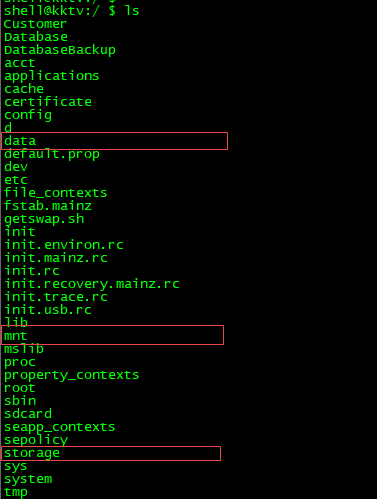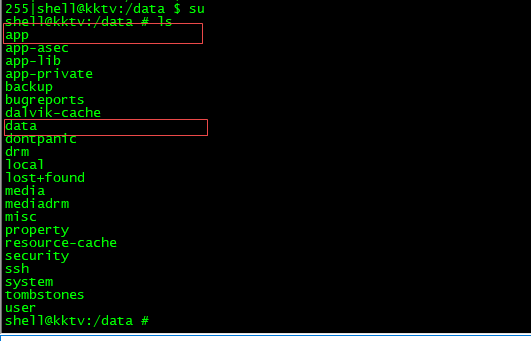一、内存、内部存储、外部存储
概述
之前公司项目,涉及到安卓获取USB路径的问题,这个问题,网上的方法千奇百怪,结合自己的项目经历,糅合了一些博文的知识,整合了自己的见解。
打开手机设置,选择应用管理,选择任意一个App,然后你会看到两个按钮,一个是清除缓存,另一个是清除数据,那么当我们点击清除缓存的时候清除的是哪里的数据?当我们点击清除数据的时候又是清除的哪里的数据?
在android开发中我们常常听到这样几个概念,内存,内部存储,外部存储,很多人常常将这三个东西搞混,那么我们今天就先来详细说说这三个东西是怎么回事?先来看张图。

内存:我们在英文中称作memory,内部存储,我们称为InternalStorage,外部存储我们称为ExternalStorage,这在英文中本不会产生歧义,但是当我们翻译为中文之后,前两个都简称为内存,于是,混了。那么究竟什么是内部存储什么是外部存储呢?

这里有三个文件夹需要我们重视,一个是data,一个是mnt,一个是storage,我们下面就详细说说这三个文件夹。
1.内部存储
data文件夹就是我们常说的内部存储,当我们打开data文件夹之后(没有root的手机不能打开该文件夹),里边有两个文件夹值得我们关注(我这里以公司的安卓样板的目录举例,不泄露任何目标,仅仅用来展示安卓目录!!!!!!!毕竟样板比较容易获取root权限,毕竟我们自己就是一手厂家,拿手机的话去root我就太麻烦了,而且会造成不可预知的损失)如下:

可以看到,我们进入data目录下后,再执行其他指令的,会显示permission denied,权限禁止,样板获取root权限,只需要 su就行啦,跟linux指令是一样的。
图片仅仅演示过程,大家只需要看标记红框的目录就行,这些目录不管是什么安卓手机,平板,安卓产品是一致的,大家只需要关注红框目录就行
获取到root权限之后,就可以看到下面两个目录了,这事着重要在意的两个目录

一个文件夹是app文件夹,还有一个文件夹就是data文件夹,app文件夹里存放着我们所有安装的app的apk文件,其实,当我们调试一个app的时候,可以看到控制台输出的内容,有一项是uploading …..就是上传我们的apk到这个文件夹,上传成功之后才开始安装。另一个重要的文件夹就是data文件夹了,这个文件夹里边都是一些包名,打开这些包名之后我们会看到这样的一些文件:
1.data/data/包名/shared_prefs
2.data/data/包名/databases
3.data/data/包名/files
4.data/data/包名/cache
我这里没往板子上拷apk,所以app目录为空,就不进去看了,看下data里头都有什么吧,

如果打开过data文件,应该都知道这些文件夹是干什么用的,我们在使用sharedPreferenced的时候,将数据持久化存储于本地,其实就是存在这个文件中的xml文件里,我们App里边的数据库文件就存储于databases文件夹中,还有我们的普通数据存储在files中,缓存文件存储在cache文件夹中,存储在这里的文件我们都称之为内部存储。
随便进一个目录看看去,这个里头东西有点少,刚好对我们胃口。

2.外部存储
外部存储才是我们平时操作最多的,外部存储一般就是我们上面看到的storage文件夹,当然也有可能是mnt文件夹,这个不同厂家有可能不一样。
一般来说,在storage文件夹中有一个sdcard文件夹,这个文件夹中的文件又分为两类,一类是公有目录,还有一类是私有目录,其中的公有目录有九大类,比如DCIM、DOWNLOAD等这种系统为我们创建的文件夹,私有目录就是Android这个文件夹,这个文件夹打开之后里边有一个data文件夹,打开这个data文件夹,里边有许多包名组成的文件夹。
说到这里,我想大家应该已经可以分清楚什么是内部存储什么是外部存储了吧?好,分清楚之后我们就要看看怎么来操作内部存储和外部存储了。
操作外部存储首先需要以下权限:
1 <uses-permission android:name="android.permission.WRITE_EXTERNAL_STORAGE" />
当你申请了write权限,那么read权限默认也就通过啦
再判断状态:
1 if (Environment.MEDIA_MOUNTED.equals(Environment.getExternalStorageState))
外部存储的根目录
1 Environment.getExternalStorageDirectory()
内外部路径汇总一览
| 路径 | 方法名 | 所属 |
|---|---|---|
| data/data/包名/shared_prefs | 内部 | |
| data/data/包名/databases | 内部 | |
| data/data/包名/files | getFilesDir() | 内部 |
| data/data/包名/cache | getCacheDir() | 内部 |
| /mnt 【外部存储】或者 /storage 【外部存储】 | Environment.getExternalStorageDirectory() | 外部根目录 |
| /storage/<type> | Environment.getExternalStoragePublicDirectory(Environment.DIRECTORY_DCIM) | 外部九大公有目录 |
| /storage/sdcard/Android/data/包名/files | getExternalFilesDir(Environment.DIRECTORY_MUSIC) | 外部私有目录 |
| /storage/sdcard/Android/data/包名/cache | getExternalCacheDir() | 外部缓存目录 |
发现特点了吗朋友,无论外部内部,只有路径中有包名,那么就是私有的,而且是随着程序的卸载而被删除的,有包名的路径均是Context中的方法,而公有的路径均是Environment调用的。
啊,朋友,我在这里我要吐槽一下,恶心啊,真的恶心,其实就那么三个路径,就因为厂家不同,搞得乱七八糟的,有得简单就嵌套一层目录,有的居然还嵌套两层进去,比如上面九大公有目录我写的是/storage/<type>,有的是在/mnt/<type>下,然后usb路径也在/mnt/usb,有的干脆是全都在/storage下,反正大家记住这些分区概念就行,到时候直接调用相关API,打印一下看一下具体目录分支吧,我也没有好的办法总结全部厂商得目录,没有厂商会觉得自己有问题。
3.操作存储空间
首先,经过上面的分析,大家已经明白了,什么是内部存储,什么是外部存储,以及这两种存储方式分别存储在什么位置,一般来说,我们不会自己去操作内部存储空间,没有root权限的话,我们也没法操作内部存储空间,事实上内部存储主要是由系统来维护的。不过在代码中我们是可以访问到这个文件夹的。由于内部存储空间有限,在开发中我们一般都是操作外部存储空间,Google官方建议我们App的数据应该存储在外部存储的私有目录中该App的包名下,这样当用户卸载掉App之后,相关的数据会一并删除,如果你直接在/storage/sdcard目录下创建了一个应用的文件夹,那么当你删除应用的时候,这个文件夹就不会被删除。
大家看到,有包名的路径我们都是调用Context中的方法来获得,没有包名的路径,我们直接调用Environment中的方法获得,那么其中有两个方法需要传入一个String类型的参数,这个参数我们使用了Environment中的常量,参数的意思是我们要访问这个路径下的哪个文件夹,比如getExternalFilesDir方法,我们看看它的源码:
1 /**
2 *
3 * @param type The type of files directory to return. May be null for
4 * the root of the files directory or one of
5 * the following Environment constants for a subdirectory:
6 * {@link android.os.Environment#DIRECTORY_MUSIC},
7 * {@link android.os.Environment#DIRECTORY_PODCASTS},
8 * {@link android.os.Environment#DIRECTORY_RINGTONES},
9 * {@link android.os.Environment#DIRECTORY_ALARMS},
10 * {@link android.os.Environment#DIRECTORY_NOTIFICATIONS},
11 * {@link android.os.Environment#DIRECTORY_PICTURES}, or
12 * {@link android.os.Environment#DIRECTORY_MOVIES}.
13 *
14 * @return The path of the directory holding application files
15 * on external storage. Returns null if external storage is not currently
16 * mounted so it could not ensure the path exists; you will need to call
17 * this method again when it is available.
18 *
19 * @see #getFilesDir
20 * @see android.os.Environment#getExternalStoragePublicDirectory
21 */
22 @Nullable
23 public abstract File getExternalFilesDir(@Nullable String type);
它的注释非常多,我这里只列出其中一部分,我们看到,我们可以访问files文件夹下的Music文件夹、Movies文件夹等等好几种。
说到这里,我想大家对内部存储、外部存储该有了一个清晰的认识了吧。我们在开发中,不建议往内部存储中写太多的数据,毕竟空间有限。外部存储在使用的时候最好能够将文件存放在私有目录下,这样有利于系统维护,也避免用户的反感。
现在我们再来看看我们一开始提出的问题,当我们点击清除数据的时候清除的是哪里的数据呢?毫无疑问,当然是内部存储目录中相应的files和cache文件夹中的文件和外部存储中相应的files和cache文件夹中的文件,至于这些文件夹的路径我想你应该已经明白了。
SD卡路径
这个货真真是要了老命,这也是我安卓学习中见到过最SB的东西,一般的方法根本不好使,结合网上有的方法加上公司项目中的方法,总结如下:
百分百好用的获取SD卡路径方法:
1 try {
2 StorageManager sm = (StorageManager) context.getSystemService(Context.STORAGE_SERVICE);
3 Method getVolumeList = null;
4 getVolumeList = sm.getClass().getDeclaredMethod("getVolumeList");
5 Object[] volumeList = (Object[]) getVolumeList.invoke(sm);
6 for (Object volume : volumeList) {
7 Method getPath = volume.getClass().getDeclaredMethod("getPath");
8 Method isRemovable = volume.getClass().getDeclaredMethod("isRemovable");
9 String path = (String) getPath.invoke(volume);
10 boolean removable = (Boolean) isRemovable.invoke(volume);
11 if (removable) {
12 paths.add(path);
13 }
14 }
15 for (String path : paths) {
16 Log.d("qwer", "path = > " + path);
17 }
18 } catch (NoSuchMethodException e) {
19 e.printStackTrace();
20 } catch (InvocationTargetException e) {
21 e.printStackTrace();
22 } catch (IllegalAccessException e) {
23 e.printStackTrace();
24 }
最后集合 path 中的值就是SD卡根目录
1 /storage/sdcard1
我这里的安卓样板是/mnt/usb/sda1,使具体情况而定吧
虽然无视版本百分百好用,但是如果你的手机有SD卡槽却没插SD卡,该方法最后 path 返回的是 null ,也就是说该方法无法判断到底是没插SD卡还是根本不支持SD卡
其实还有一种方法
1 String path = System.getenv("SECONDARY_STORAGE");
该方法只要你手机支持SD卡,无论你插没插SD卡,均会返回SD卡路径,但是6.0及以上该方法被移除
Environment中源码其实就是根据这个方法获取路径的
安卓官方文档大家一定要看,他就是我们开发者的权威呀,圣经呀!!
Android外部存储/内部存储路径获取大全
1 public class DirectoryUtils {
2 private static final String TAG = "DirectoryUtils";
3 public static void getEnvironmentDirectories() {
4 //:/system
5 String rootDir = Environment.getRootDirectory().toString();
6 System.out.println("Environment.getRootDirectory()=:" + rootDir);
7 //:/data 用户数据目录
8 String dataDir = Environment.getDataDirectory().toString();
9 System.out.println("Environment.getDataDirectory()=:" + dataDir);
10 //:/cache 下载缓存内容目录
11 String cacheDir = Environment.getDownloadCacheDirectory().toString();
12 System.out.println("Environment.getDownloadCacheDirectory()=:" + cacheDir);
13 //:/mnt/sdcard或者/storage/emulated/0或者/storage/sdcard0 主要的外部存储目录
14 //这个不一定是外部存储
15 String storageDir = Environment.getExternalStorageDirectory().toString();
16 System.out.println("Environment.getExternalStorageDirectory()=:" + storageDir);
17 //:/mnt/sdcard/Pictures或者/storage/emulated/0/Pictures或者/storage/sdcard0/Pictures
18 String publicDir = Environment.getExternalStoragePublicDirectory(Environment.DIRECTORY_PICTURES).toString();
19 System.out.println("Environment.getExternalStoragePublicDirectory()=:" + publicDir);
20 //获取SD卡是否存在:mounted
21 String storageState = Environment.getExternalStorageState().toLowerCase();
22 System.out.println("Environment.getExternalStorageState()=:" + storageState);
23 //设备的外存是否是用内存模拟的,是则返回true。(API Level 11)
24 boolean isEmulated = Environment.isExternalStorageEmulated();
25 System.out.println("Environment.isExternalStorageEmulated()=:" + isEmulated);
26 //设备的外存是否是可以拆卸的,比如SD卡,是则返回true。(API Level 9)
27 boolean isRemovable = Environment.isExternalStorageRemovable();
28 System.out.println("Environment.isExternalStorageRemovable()=:" + isRemovable);
29 }
30 public static void getApplicationDirectories(Context context) {
31 //获取当前程序路径 应用在内存上的目录 :/data/data/com.mufeng.toolproject/files
32 String filesDir = context.getFilesDir().toString();
33 System.out.println("context.getFilesDir()=:" + filesDir);
34 //应用的在内存上的缓存目录 :/data/data/com.mufeng.toolproject/cache
35 String cacheDir = context.getCacheDir().toString();
36 System.out.println("context.getCacheDir()=:" + cacheDir);
37 //应用在外部存储上的目录 :/storage/emulated/0/Android/data/com.mufeng.toolproject/files/Movies
38 String externalFilesDir = context.getExternalFilesDir(Environment.DIRECTORY_MOVIES).toString();
39 System.out.println("context.getExternalFilesDir()=:" + externalFilesDir);
40 //应用的在外部存储上的缓存目录 :/storage/emulated/0/Android/data/com.mufeng.toolproject/cache
41 String externalCacheDir = context.getExternalCacheDir().toString();
42 System.out.println("context.getExternalCacheDir()=:" + externalCacheDir);
43 //获取该程序的安装包路径 :/data/app/com.mufeng.toolproject-3.apk
44 String packageResourcePath = context.getPackageResourcePath();
45 System.out.println("context.getPackageResourcePath()=:" + packageResourcePath);
46 //获取程序默认数据库路径 :/data/data/com.mufeng.toolproject/databases/mufeng
47 String databasePat = context.getDatabasePath("mufeng").toString();
48 System.out.println("context.getDatabasePath(\"mufeng\")=:" + databasePat);
49 }
50 }
好了,最后再送给大家一个文件操作工具类:
1 public class SDCardHelper { 2 3 // 判断SD卡是否被挂载 4 public static boolean isSDCardMounted() { 5 // return Environment.getExternalStorageState().equals("mounted"); 6 return Environment.getExternalStorageState().equals( 7 Environment.MEDIA_MOUNTED); 8 } 9 10 // 获取SD卡的根目录 11 public static String getSDCardBaseDir() { 12 if (isSDCardMounted()) { 13 return Environment.getExternalStorageDirectory().getAbsolutePath(); 14 } 15 return null; 16 } 17 18 // 获取SD卡的完整空间大小,返回MB 19 public static long getSDCardSize() { 20 if (isSDCardMounted()) { 21 StatFs fs = new StatFs(getSDCardBaseDir()); 22 long count = fs.getBlockCountLong(); 23 long size = fs.getBlockSizeLong(); 24 return count * size / 1024 / 1024; 25 } 26 return 0; 27 } 28 29 // 获取SD卡的剩余空间大小 30 public static long getSDCardFreeSize() { 31 if (isSDCardMounted()) { 32 StatFs fs = new StatFs(getSDCardBaseDir()); 33 long count = fs.getFreeBlocksLong(); 34 long size = fs.getBlockSizeLong(); 35 return count * size / 1024 / 1024; 36 } 37 return 0; 38 } 39 40 // 获取SD卡的可用空间大小 41 public static long getSDCardAvailableSize() { 42 if (isSDCardMounted()) { 43 StatFs fs = new StatFs(getSDCardBaseDir()); 44 long count = fs.getAvailableBlocksLong(); 45 long size = fs.getBlockSizeLong(); 46 return count * size / 1024 / 1024; 47 } 48 return 0; 49 } 50 51 // 往SD卡的公有目录下保存文件 52 public static boolean saveFileToSDCardPublicDir(byte[] data, String type, String fileName) { 53 BufferedOutputStream bos = null; 54 if (isSDCardMounted()) { 55 File file = Environment.getExternalStoragePublicDirectory(type); 56 try { 57 bos = new BufferedOutputStream(new FileOutputStream(new File(file, fileName))); 58 bos.write(data); 59 bos.flush(); 60 return true; 61 } catch (Exception e) { 62 e.printStackTrace(); 63 } finally { 64 try { 65 bos.close(); 66 } catch (IOException e) { 67 // TODO Auto-generated catch block 68 e.printStackTrace(); 69 } 70 } 71 } 72 return false; 73 } 74 75 // 往SD卡的自定义目录下保存文件 76 public static boolean saveFileToSDCardCustomDir(byte[] data, String dir, String fileName) { 77 BufferedOutputStream bos = null; 78 if (isSDCardMounted()) { 79 File file = new File(getSDCardBaseDir() + File.separator + dir); 80 if (!file.exists()) { 81 file.mkdirs();// 递归创建自定义目录 82 } 83 try { 84 bos = new BufferedOutputStream(new FileOutputStream(new File(file, fileName))); 85 bos.write(data); 86 bos.flush(); 87 return true; 88 } catch (Exception e) { 89 e.printStackTrace(); 90 } finally { 91 try { 92 bos.close(); 93 } catch (IOException e) { 94 // TODO Auto-generated catch block 95 e.printStackTrace(); 96 } 97 } 98 } 99 return false; 100 } 101 102 // 往SD卡的私有Files目录下保存文件 103 public static boolean saveFileToSDCardPrivateFilesDir(byte[] data, String type, String fileName, Context context) { 104 BufferedOutputStream bos = null; 105 if (isSDCardMounted()) { 106 File file = context.getExternalFilesDir(type); 107 try { 108 bos = new BufferedOutputStream(new FileOutputStream(new File(file, fileName))); 109 bos.write(data); 110 bos.flush(); 111 return true; 112 } catch (Exception e) { 113 e.printStackTrace(); 114 } finally { 115 try { 116 bos.close(); 117 } catch (IOException e) { 118 // TODO Auto-generated catch block 119 e.printStackTrace(); 120 } 121 } 122 } 123 return false; 124 } 125 126 // 往SD卡的私有Cache目录下保存文件 127 public static boolean saveFileToSDCardPrivateCacheDir(byte[] data, String fileName, Context context) { 128 BufferedOutputStream bos = null; 129 if (isSDCardMounted()) { 130 File file = context.getExternalCacheDir(); 131 try { 132 bos = new BufferedOutputStream(new FileOutputStream(new File(file, fileName))); 133 bos.write(data); 134 bos.flush(); 135 return true; 136 } catch (Exception e) { 137 e.printStackTrace(); 138 } finally { 139 try { 140 bos.close(); 141 } catch (IOException e) { 142 // TODO Auto-generated catch block 143 e.printStackTrace(); 144 } 145 } 146 } 147 return false; 148 } 149 150 // 保存bitmap图片到SDCard的私有Cache目录 151 public static boolean saveBitmapToSDCardPrivateCacheDir(Bitmap bitmap, String fileName, Context context) { 152 if (isSDCardMounted()) { 153 BufferedOutputStream bos = null; 154 // 获取私有的Cache缓存目录 155 File file = context.getExternalCacheDir(); 156 157 try { 158 bos = new BufferedOutputStream(new FileOutputStream(new File(file, fileName))); 159 if (fileName != null && (fileName.contains(".png") || fileName.contains(".PNG"))) { 160 bitmap.compress(Bitmap.CompressFormat.PNG, 100, bos); 161 } else { 162 bitmap.compress(Bitmap.CompressFormat.JPEG, 100, bos); 163 } 164 bos.flush(); 165 } catch (Exception e) { 166 e.printStackTrace(); 167 } finally { 168 if (bos != null) { 169 try { 170 bos.close(); 171 } catch (IOException e) { 172 e.printStackTrace(); 173 } 174 } 175 } 176 return true; 177 } else { 178 return false; 179 } 180 } 181 182 // 从SD卡获取文件 183 public static byte[] loadFileFromSDCard(String fileDir) { 184 BufferedInputStream bis = null; 185 ByteArrayOutputStream baos = new ByteArrayOutputStream(); 186 187 try { 188 bis = new BufferedInputStream(new FileInputStream(new File(fileDir))); 189 byte[] buffer = new byte[8 * 1024]; 190 int c = 0; 191 while ((c = bis.read(buffer)) != -1) { 192 baos.write(buffer, 0, c); 193 baos.flush(); 194 } 195 return baos.toByteArray(); 196 } catch (Exception e) { 197 e.printStackTrace(); 198 } finally { 199 try { 200 baos.close(); 201 bis.close(); 202 } catch (IOException e) { 203 e.printStackTrace(); 204 } 205 } 206 return null; 207 } 208 209 // 从SDCard中寻找指定目录下的文件,返回Bitmap 210 public Bitmap loadBitmapFromSDCard(String filePath) { 211 byte[] data = loadFileFromSDCard(filePath); 212 if (data != null) { 213 Bitmap bm = BitmapFactory.decodeByteArray(data, 0, data.length); 214 if (bm != null) { 215 return bm; 216 } 217 } 218 return null; 219 } 220 221 // 获取SD卡公有目录的路径 222 public static String getSDCardPublicDir(String type) { 223 return Environment.getExternalStoragePublicDirectory(type).toString(); 224 } 225 226 // 获取SD卡私有Cache目录的路径 227 public static String getSDCardPrivateCacheDir(Context context) { 228 return context.getExternalCacheDir().getAbsolutePath(); 229 } 230 231 // 获取SD卡私有Files目录的路径 232 public static String getSDCardPrivateFilesDir(Context context, String type) { 233 return context.getExternalFilesDir(type).getAbsolutePath(); 234 } 235 236 public static boolean isFileExist(String filePath) { 237 File file = new File(filePath); 238 return file.isFile(); 239 } 240 241 // 从sdcard中删除文件 242 public static boolean removeFileFromSDCard(String filePath) { 243 File file = new File(filePath); 244 if (file.exists()) { 245 try { 246 file.delete(); 247 return true; 248 } catch (Exception e) { 249 return false; 250 } 251 } else { 252 return false; 253 } 254 } 255 }



 浙公网安备 33010602011771号
浙公网安备 33010602011771号